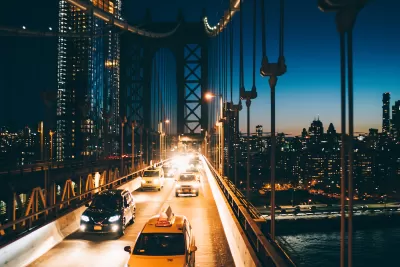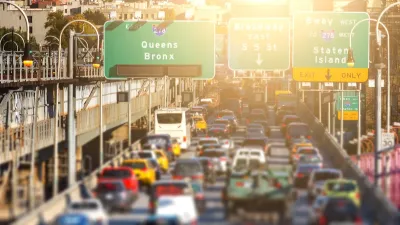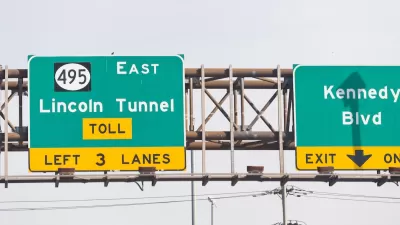The long-awaited congestion pricing program began on January 5.

New York City’s congestion pricing program is now in effect (you can trace the saga of the controversial program on Planetizen’s archives), and Dave Colon of Streetsblog NYC has all the facts you need to know as a, NYC driver or resident.
As Colon explains, “At the most basic level, the toll to drive into the area of Manhattan below 60th Street has a peak period from 5 a.m. to 9 p.m. Monday through Friday, and 9 a.m. to 9 p.m. on Saturday and Sunday. The remaining hours are considered the ‘overnight’ period.”
The cost to enter the congestion pricing zone varies for passenger cars, small trucks and charter buses, tractor trailers, intercity buses and school buses, tour buses, motorcycles, yellow or green cabs, and ride-hailing service vehicles. Costs for passenger vehicles are $2.25 off-peak and $9 at peak hours. Tolls are roughly 50 percent higher for drivers without at E-Z Pass.
Colon reminds readers that the $9 toll was lowered from a proposed $15 rate, and that “The vast majority of people who get into the central business district use transit — and those who drive are, on average, wealthier than their transit-using neighbors.”
Congestion pricing is expected to raise $500 million per year, funds that will go toward public transit in the region. As Colon notes, “In the world of big money borrowing, congestion pricing is a totally separate and new revenue stream from the MTA's normal fare- and toll-backed revenues that the agency has used to pay off its bonds. Congestion pricing is that rarest of things in politics: a reliable revenue stream.”
FULL STORY: Congestion Pricing Has Begun! Here is the ONLY Explainer You Need

Alabama: Trump Terminates Settlements for Black Communities Harmed By Raw Sewage
Trump deemed the landmark civil rights agreement “illegal DEI and environmental justice policy.”

Planetizen Federal Action Tracker
A weekly monitor of how Trump’s orders and actions are impacting planners and planning in America.

The 120 Year Old Tiny Home Villages That Sheltered San Francisco’s Earthquake Refugees
More than a century ago, San Francisco mobilized to house thousands of residents displaced by the 1906 earthquake. Could their strategy offer a model for the present?

LA’s Tree Emergency Goes Beyond Vandalism
After a vandal destroyed dozens of downtown LA trees, Mayor Karen Bass vowed to replace them. Days later, she slashed the city’s tree budget.

Sacramento Leads Nation With Bus-Mounted Bike Lane Enforcement Cameras
The city is the first to use its bus-mounted traffic enforcement system to cite drivers who park or drive in bike lanes.

Seattle Voters Approve Social Housing Referendum
Voters approved a corporate tax to fund the city’s housing authority despite an opposition campaign funded by Amazon and Microsoft.
Urban Design for Planners 1: Software Tools
This six-course series explores essential urban design concepts using open source software and equips planners with the tools they need to participate fully in the urban design process.
Planning for Universal Design
Learn the tools for implementing Universal Design in planning regulations.
Ada County Highway District
Clanton & Associates, Inc.
Jessamine County Fiscal Court
Institute for Housing and Urban Development Studies (IHS)
City of Grandview
Harvard GSD Executive Education
Toledo-Lucas County Plan Commissions
Salt Lake City
NYU Wagner Graduate School of Public Service





























